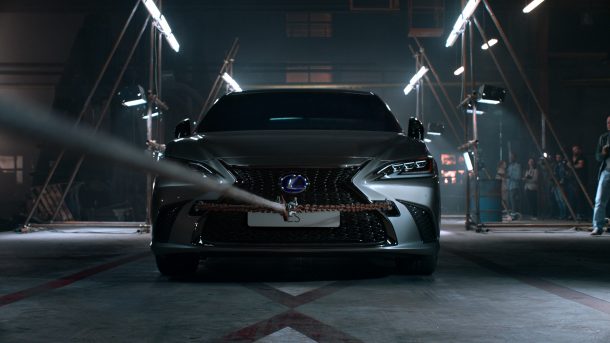Lexus Lets Artificial Intelligence Write Car Commercial, Mild Weirdness Ensues

Automakers are obsessed with promoting high-tech concepts in an effort to prove to investors and the general public that they aren’t falling behind the times. While artificial intelligence remains the gold standard, what constitutes A.I. can get a little foggy. However, in the present, the term can be used to describe any machine that effectively mimics cognitive behaviors, like the ability to learn or create.
Car manufacturers want to fine tune specific A.I. examples to be implemented in autonomous driving hardware and high-end, modern infotainment systems. For example Mercedes-Benz wants to use the technology to build a more serious relationship between drivers and its cars by allowing future vehicles to “learn” about the driver. Meanwhile, General Motors decided to branch out to see how such a system would handle marketing by linking up OnStar Go with IBM’s Watson, an A.I. which famously beat Jeopardy champion Ken Jennings.
Watson is now working with Lexus and taking things a step further. The automaker just released a new advertisement it claims was written by IBM’s machine and directed by Kevin Macdonald.
The commercial isn’t nonsensical but there is a strangeness to it that could be confused by westerners as “distinctly Japanese.” While it does have some Japanese flare, there’s really nothing that overtly ties it to the nation.
In truth, the Land of the Rising Sun’s best television spots are reminiscent of high-energy, Western toy commercials from the 90s. Intense scenarios are downplayed while mundane ones are elevated for comedic effect. Costumes and wild antics are par for the course and can appear in everything from candy ads to commercials promoting employment agencies.
This car ad is comparatively somber, focusing on a Lexus Takumi Master Craftsman frets over the new Lexus ES he ushered down the assembly line. But how did the computer know what direction to take with the script and why isn’t it a jumbled series of themed images?
Lexus’ creative agency The&Partnership London collaborated with technical partner Visual Voice to “create the A.I. scriptwriter,” using Watson to analyze years of audio, text, and visual data and extract “what makes content award worthy” and entertaining for an audience. It was also primed with “emotional intelligence data” from the video marketplace Unruly to learn which moments connected most strongly with viewers and understand how actions, objects, locations, and emotionality are used in different combinations and sequences to communicate the desired messages. From there, Kevin Macdonald (director of The Last King of Scotland) was approached to direct.
However, while Lexus is framing the event as the first advertisement written by a computer, that’s not entirely accurate. The A.I. may have drafted the script and outline, but the creative agencies had to finalize the plot. Although, that’s not terribly uncommon when advertisers are using human writers.
The big difference is that, by using an A.I., Lexus can tie the ads’ very existence to its technological might. It’s not a coincidence that the big twist in the commercial is when the Lexus’ automatic emergency braking stops it from being demolished in a crash test — which is being nationally televised from a sketchy looking warehouse for some reason.
“When I was handed the script, the melodrama of the story convinced me of its potential,” said Macdonald.
That non-human edge is an essential part of the marketing campaign and getting eyes on the project. In fact, other portions of the marketing team were claiming computers were on the cusp of becoming legitimate artists.
“This was both a highly challenging and deeply fascinating project to have had the privilege to be a part of. From the outset, it was almost impossible to know what level of quality or intelligibility the AI would produce,” said Alex Newland, Co-Founder of Visual Voice in a statement. “To see the project brought together with such a rich finished piece is extremely satisfying and exciting to witness. We believe this project moves AI-generated content into the beginnings of true, stand-alone creative merit.”
Considering Rutgers University already has A.I. systems producing new works of art, although none of them are screenwriters, we’re not certain Lexus’ “Driven by Intuition” marketing campaign is so much the birth of a new creative moment as it is a good opportunity for a car-brand to promote its technology. That said, the artificial intelligence angle does make the ad more enticing to unpack — even if there isn’t anything of substance to clear up. We’ll probably never know if the computer decided to script the bit where the car chose to save itself, pleading for humanity to acknowledge its sentience, or if that was added by the marketing team later.
[Images: Lexus]

A staunch consumer advocate tracking industry trends and regulation. Before joining TTAC, Matt spent a decade working for marketing and research firms based in NYC. Clients included several of the world’s largest automakers, global tire brands, and aftermarket part suppliers. Dissatisfied with the corporate world and resentful of having to wear suits everyday, he pivoted to writing about cars. Since then, that man has become an ardent supporter of the right-to-repair movement, been interviewed on the auto industry by national radio broadcasts, driven more rental cars than anyone ever should, participated in amateur rallying events, and received the requisite minimum training as sanctioned by the SCCA. Handy with a wrench, Matt grew up surrounded by Detroit auto workers and managed to get a pizza delivery job before he was legally eligible. He later found himself driving box trucks through Manhattan, guaranteeing future sympathy for actual truckers. He continues to conduct research pertaining to the automotive sector as an independent contractor and has since moved back to his native Michigan, closer to where the cars are born. A contrarian, Matt claims to prefer understeer — stating that front and all-wheel drive vehicles cater best to his driving style.
More by Matt Posky
Latest Car Reviews
Read moreLatest Product Reviews
Read moreRecent Comments
- GrumpyOldMan All modern road vehicles have tachometers in RPM X 1000. I've often wondered if that is a nanny-state regulation to prevent drivers from confusing it with the speedometer. If so, the Ford retro gauges would appear to be illegal.
- Theflyersfan Matthew...read my mind. Those old Probe digital gauges were the best 80s digital gauges out there! (Maybe the first C4 Corvettes would match it...and then the strange Subaru XT ones - OK, the 80s had some interesting digital clusters!) I understand the "why simulate real gauges instead of installing real ones?" argument and it makes sense. On the other hand, with the total onslaught of driver's aid and information now, these screens make sense as all of that info isn't crammed into a small digital cluster between the speedo and tach. If only automakers found a way to get over the fallen over Monolith stuck on the dash design motif. Ultra low effort there guys. And I would have loved to have seen a retro-Mustang, especially Fox body, have an engine that could rev out to 8,000 rpms! You'd likely be picking out metal fragments from pretty much everywhere all weekend long.
- Analoggrotto What the hell kind of news is this?
- MaintenanceCosts Also reminiscent of the S197 cluster.I'd rather have some original new designs than retro ones, though.
- Fahrvergnugen That is SO lame. Now if they were willing to split the upmarketing price, different story.





































Comments
Join the conversation
"While it does have some Japanese flare (sic)" What, like a damp squib? That's flair for us English speakers. Or is flare AI for flair? ESes are handmade by bots in Kentucky so far as I know - not much Japan Inc about them and certainly not lovingly caressed by some Japanese senior citizen. But don't tell the bots the truth or they'll get confused.
Watched it with the sound off. My takeaways: Factory inspector with a "dear god what have I done" look Car driving on a road Bogus "crash test" with a winch Car applies brakes, holy cow look at that, a car that comes with brakes! "Self-charging hybrid" so it's just a hybrid?